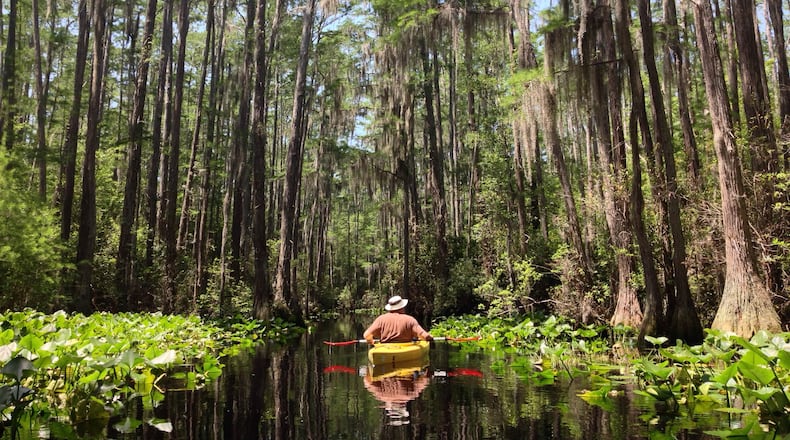Home to 430,000 acres of unspoiled wetlands, thousands of species of plants and animals, and millions of tons of carbon-rich peat, Georgia’s Okefenokee National Wildlife Refuge has long been viewed as an ecological gem worthy of global recognition.
Now, a push is underway to bring even more international acclaim to the refuge. Last week, the federal National Park Service (NPS) announced it is preparing to nominate the Okefenokee for listing as a World Heritage Site.
A spot on the United Nations Educational, Scientific and Cultural Organization’s (UNSECO) World Heritage List is a prestigious honor, one reserved for sites like the Acropolis of Athens and the Grand Canyon, that possess “outstanding universal value.” Places must meet at least one of the program’s 10 criteria for selection, which include factors like “exceptional natural beauty” or “biological diversity,” especially for threatened species.
The Okefenokee’s nomination has been a long time coming — The refuge has been on the Department of the Interior’s shortlist for submission for more than 40 years.
For the swamp’s defenders, the potential bid is welcome news, but it comes at a time of angst about the future of the ecosystem.
Alabama-based Twin Pines Minerals continues to seek permits from Georgia environmental regulators to develop a controversial titanium mine within three miles of the swamp’s edge. The company says the project will not harm the ecosystem, but several prominent scientists — including some of the NPS’ own hydrologists — have questioned those claims.
With both the World Heritage push and the mine set to move forward, here’s what you need to know.
Why is World Heritage status significant?
The Okefenokee already welcomes around 700,000 visitors a year and is a key contributor to Southeast Georgia’s rural economy. World Heritage recognition could lift the swamp’s profile as a tourist destination even higher and deliver a significant boost to the local economy.
Charlton County, which includes a large chunk of the refuge and rural areas along its eastern border, has a median household income of just over $45,000, nearly $20,000 less than the statewide median.
The refuge would be the first-ever World Heritage-nominated site from Georgia and, if the bid is successful, the first location managed by the U.S. Fish and Wildlife Service.
Will the bid create legal hurdles for the mine?
The Okefenokee’s World Heritage bid will likely to draw increased attention to the Twin Pines mine, but it won’t place any additional legal obstacles in front of the project.
Right now, permitting for the mine is solely in the hands of Georgia’s Environmental Protection Division (EPD).
According to National Park Service’s notice posted last week about the Okefenokee’s nomination, the agency noted that, “Neither inclusion in the list nor inscription as a World Heritage Site imposes legal restrictions on owners or neighbors of sites ...”
The notice said World Heritage status does not give the United Nations any management authority over sites and said the site would only be subject to U.S. laws.
Could the mine harm the Okefenokee’s nomination?
It’s too soon to tell.
A UNESCO spokesperson said the organization does not comment on nominations, but added that “experts always take into account all available data on the property, including development projects.”
UNESCO’s World Heritage Committee, which will have final say on the Okefenokee’s bid, does maintain a list of endangered World Heritage sites. Those include places in Ukraine, Iraq and other countries threatened by conflict, natural disasters, human development and more.
The only U.S. location on the list is another vast wetland landscape — Everglades National Park — which is facing water supply and quality issues.
The National Park Service and the Department of the Interior did not immediately respond to multiple requests for comment on whether the proposed mine could affect the Okefenokee’s nomination.
When will the refuge be nominated?
Those involved say it’s expected to be a multi-year process.
Kim Bednarek, who is helping to craft the bid as the executive director of the Okefenokee Swamp Park — the refuge’s nonprofit partner — said a draft nomination likely won’t be ready until 2024.
From there, Bednarek said the aim is to formally nominate the refuge in February 2025, putting it on track for final consideration by the World Heritage Committee in 2026.
Right now, Bednarek said the most important thing citizens can do is voice their support for the Okefenokee’s bid.
“We need Georgians to get behind this inscription process because it’s a Georgia treasure,” she said.
What’s the latest on the Twin Pines mine?
The company is still seeking the permits it needs from Georgia environmental regulators for the 580-acre titanium mine.
During a two-month public comment period on the company’s draft mining plans that was open in the spring, Georgia EPD received more than 77,000 comments.
EPD staff have since completed a review of those comments and have asked the company to provide more details on certain aspects of the mining plan. EPD did not clarify exactly what additional information it’s seeking, but the department’s newly-minted chief, Director Jeff Cown, said in an interview before the Department of Natural Resources’ board meeting on Tuesday that, “It’s in their (Twin Pines’) court.”
“We’re waiting on them to respond to us,” he added.
Asked whether the Okefenokee’s potential nomination as a World Heritage Site would affect his department’s review of the company’s plans, he said he’d look into it, but added that, “We’d protect it whether it’s a World Heritage Site or not.”
A note of disclosure
This coverage is supported by a partnership with 1Earth Fund, the Kendeda Fund and Journalism Funding Partners. You can learn more and support our climate reporting by donating at ajc.com/donate/climate/
About the Author
Keep Reading
The Latest
Featured




